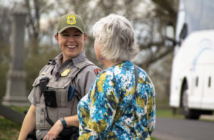Gettysburg National Military Park Volunteer Bob Scappini Rehabilitates Battlefield’s Historic Stone Walls
By Lisa Gregory | Photography by Melissa Ring
Bob Scappini had a stone wall fall on him once.
That sort of thing can happen when you volunteer your days rehabilitating the historic stone walls on the Gettysburg Battlefield.
“It was a very old wall, and the foundation was made out of granite and very crumbly,” recalls Scappini. “I was trying to unstack it so I could redo it over again. And the wall just came down right on the top of my leg.
“It comes with the job.”
And on a miserably hot and humid summer morning, Scappini was at it again, intently working on a stretch of stone wall behind the New York State Auxiliary Monument. One can’t help but notice the dark, deep bruise under his fingernail. Yep, that too was the result of his work. “Stone walls can be temperamental,” he says. “They can bite back.”
For the last three years, Scappini has worked diligently tearing down and restacking the stone walls that dot the landscape of the Gettysburg National Military Park in an effort to return them to their earlier glory. A retired U.S. history teacher from Rhode Island, Scappini moved to Gettysburg a few years ago, bringing with him a unique set of skills. And Randy Hill, supervisory facility operations specialist for landscape preservation at the park, was delighted to discover him.
“He wanted to volunteer at the park,” recalls Hill. “He said, ‘I’ll do anything you need.’”
Hill took that to heart. “I said, ‘It would be great if you knew how to do dry stack stone,’” he says. “He told me, ‘I can do that.’ I thought he was messing with me.”
He wasn’t.
There are 27 miles of stone walls that need tending to, according to Hill. Scappini has worked on three miles of them, including along Emmitsburg Road, south of the Peach Orchard, and along Taneytown Road.
Scappini is not the only volunteer to tackle the stone walls. But he has lasted the longest.
“We’ve had some that wanted to do it and then they do it for a week or so and never come back,” says Hill. “And Bob does a great job.”
With falling walls and smashed fingers, it is not an easy task. Time consuming and physically demanding, Scappini can lift up to 800 pounds of stones in a single week. Not bad for a man who suffers from both sciatica and arthritis.
“I would ask him when he finished a wall, ‘Do you want to move on to something else?’” says Hill. “’But he likes the stone walls.”
Scappini says it is therapeutic for him. “It’s Zen,” he says of the four to six hours a day he spends working on the walls. The stones must be placed just so to make sure they hold, requiring keen concentration—much like a game of Jenga, but with heavy stones. With very few exceptions, Scappini works mostly alone. In the summer, he begins early in the morning, before the heat settles in. He also works during the winter unless the temperature drops below 28 degrees. “That’s my stopping point,” he says.
Scappini comes prepared with gloves, a hammer for breaking stones, bug spray, a hot or cold drink, and a transistor radio among other items. He can go through 50 pairs of gloves in a single year. And, according to Hill, Scappini often supplies his own tools that he picks up at yard sales. But, if he needs something, Hill makes sure he gets it, he says.
The stone walls Scappini works on have a history of their own. Farmers clearing their land long ago would toss rocks aside as they found them. Some were just dumped and created a natural boundary, while others were constructed with greater care. According to Hill, the Dutch and Germans were known for taking more time and effort in crafting their walls.
The walls can and have lasted 100 years. But time and the elements take their toll.
“They steadily fall and deteriorate and become just a pile of stones,” says Hill, thus, the need to rehabilitate them. However, Scappini’s work is not the first time they have been rehabilitated. For example, during World War II, Germans being kept at a prisoner of war camp at the battlefield site were assigned to the task. Not surprisingly, “their heart wasn’t in it,” says Scappini.
“I had to take the whole wall apart and reconstruct it.”
And, of course, the stone walls were silent witness to those three days in July 1863. And sometimes they became part of that battle. Stone walls could provide defensive cover or constrain and contain advancing soldiers by providing a barrier within the battlefield itself.
“They are a part of sacred ground,” says Scappini. Not to be replaced, but to be restacked.
“I follow the architecture that’s already there,” he says.
The structure of the walls consists of a base layer of large stones, an outer structure, the middle or heart of the wall, and, finally, the capstones, which prevent water from seeping into the center of the wall. The heart of the wall, consisting of broken stones or rubble, is key to the formation of a well-built wall, says Scappini.
“Without a good heart, the wall will fall apart,” he is known to say.
And there is much to discover within those walls of stone. Besides his encounters with black snakes, chipmunks, frogs, turtles, mice, moles, voles, ticks, and ants, Scappini has come across 19th century glassware and earthenware, among other items. He turns over these items to the park service.
Scappini’s foray into historic preservation began when his son needed community service hours for school. Father and son looked over the options and one in particular—cleaning up a cemetery—caught Scappini’s eye. His son agreed, and the two went to work.
Once the project was completed, his son was done. Scappini was not. “I just kept going, and I would go in the woods and reclaim old cemeteries,” he says. “Cemeteries going back to the 1700s, early 1700s. Farms that had their own consecrated ground.”
On these excursions he would reconstruct the walls, fix the iron gates, clean the headstones. And he was learning a lot along the way, including a skill that would prove useful once he retired and moved to Gettysburg.
“There were these two Portuguese brothers who were rebuilding the stone wall in the main cemetery in Coventry, Rhode Island,” says Scappini. “ I asked them if I could hang around and watch them work. They said sure. I learned to build stone walls the Portuguese way.”
And Scappini, who once was named Rhode Island History Teacher of the Year, found a way to incorporate his work with the cemeteries into his classroom.
“I saw each tombstone as a history textbook,” he says. “It tells a story of a period of time. So I took this back to the classroom. I said to my students, ‘We’re going to go visit a cemetery.’ As we walked through the cemetery, I said, ‘I want you to write down information from one headstone that you see. And you’re going to take the persona of that person, and you have to write about that period of time.’”
One of his students noticed that there was a line of small children’s headstones all with the dates of 1917 and 1918—during the influenza epidemic, says Scappini.
Another story came from two headstones side by side with the same dates of death in the mid-1800s. Research revealed that a young girl fell through the ice and her brother jumped in to save her.
But his former high school students weren’t the only ones getting an education. His first year working at the park, participants in the American Conservation Experience (ACE), which engages young adults in conservation experiences with the National Park Service, joined him in his wall rehabilitation work. Natalie Bergeron was one of them. The assignment was not what she had expected.
“I thought we would be doing trail maintenance, that sort of thing,” says Bergeron, who is now studying conversation science in Florida. “But this was a cool surprise.”
And a special one. “I told the kids from ACE that they should consider it an honor because no one is allowed to touch this without permission,” says Scappini of the walls. “And that when you are driving your grandchildren past this place, you will point and say, ‘I did that.’ I told them that it was a privilege to be working on this.”
A sentiment that Bergeron came to appreciate.
“You’re putting the rocks on and building it the way that people did so long ago,” says Bergeron. “ I felt very grounded to my surroundings and to the history of this country.”
As for the quiet, focused man leading the project?
“I remember being impressed by his resilience,” says Bergeron of Scappini.
By now, Scappini and his stone walls work are well known in the Gettysburg area. He is often referred to as the “stone wall guy.” And he has had more than his share of interactions with tourists and others.
“One time I was working on a wall, and a man pulls up and rolls down his car window and says, ‘Did you know Gen. Meade put his foot on that rock while he was thinking about the battle?’”
A rather precise statement. And whether the man was joking or not, Scappini understands the historical enticement of the place.
“When you are sitting there after filling some rock and you are sweaty and you’re tired, you look up and there’s where Pickett’s Charge took place,” he says. “It’s incredible. I used to teach this all the time in U.S. History, and here
I am. It doesn’t get any better.”




